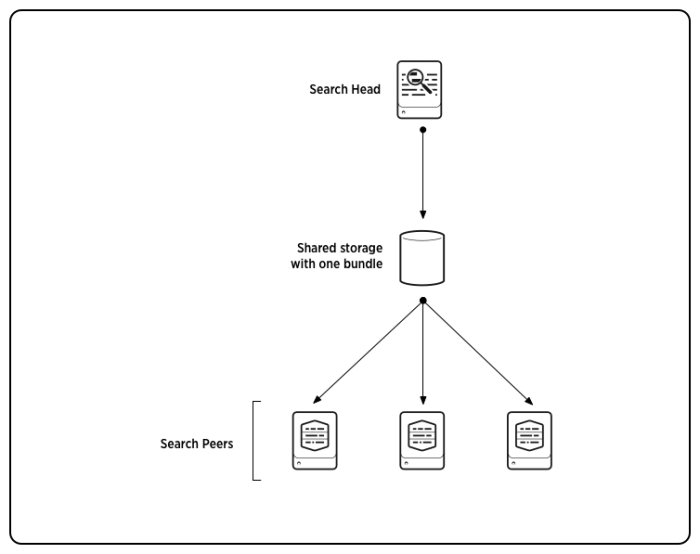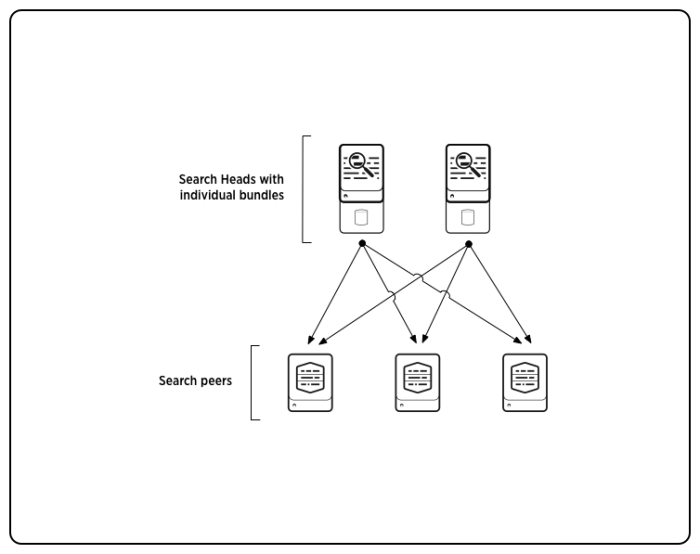About mounted bundles
Important: For most deployments, Splunk recommends that you use normal bundle replication, not mounted bundles with shared storage. As a result of changes to bundle replication made in the 5.0 timeframe, such as the introduction of delta-based replication and improvements in streaming, the practical use case for mounted bundles is now extremely limited. In most cases, mounted bundles make little difference in the amount of network traffic or the speed at which bundle changes get distributed to the search peers. At the same time, they add significant management complexity, particularly when combined with shared storage. Because of delta-based replication, even if your configurations contain large files, normal bundle replication entails little ongoing replication cost, as long as those files rarely change.
The set of data that a search head distributes to its search peers is called the knowledge bundle. The bundle contents reside in the search head's $SPLUNK_HOME/etc/{apps,users,system} subdirectories. For information on the contents and purpose of this bundle, see "What search heads send to search peers".
By default, the search head replicates and distributes the knowledge bundle to each search peer. You can instead tell the search peers to mount the knowledge bundle's directory location, eliminating the need for bundle replication. When you mount a knowledge bundle on shared storage, it's referred to as a mounted bundle.
Caution: Most shared storage solutions don't work well across a WAN. Since mounted bundles require shared storage, you generally should not implement them across a WAN.
Mounted bundle architectures
Depending on your search head configuration, there are a number of ways to set up mounted bundles. These are some of the typical ones:
- For a single search head. Mount the knowledge bundle on shared storage. All the search peers then access the bundle to process search requests. This diagram illustrates a single search head with a mounted bundle on shared storage:
- For multiple non-clustered search heads. Maintain the knowledge bundle(s) on each search head's local storage. In this diagram, each search head maintains its own bundle, which each search peer mounts and accesses individually:
In each case, the search peers need access to each search head's $SPLUNK_HOME/etc/{apps,users,system} subdirectories.
The search peers use the mounted directories only when fulfilling the search head's search requests. For indexing and other purposes not directly related to distributed search, the search peers will use their own, local apps, users, and system directories, the same as any other indexer.
| Modify the knowledge bundle | Configure mounted bundles |
This documentation applies to the following versions of Splunk® Enterprise: 7.0.0, 7.0.1, 7.0.2, 7.0.3, 7.0.4, 7.0.5, 7.0.6, 7.0.7, 7.0.8, 7.0.9, 7.0.10, 7.0.11, 7.0.13, 7.1.0, 7.1.1, 7.1.2, 7.1.3, 7.1.4, 7.1.5, 7.1.6, 7.1.7, 7.1.8, 7.1.9, 7.1.10, 7.2.0, 7.2.1, 7.2.2, 7.2.3, 7.2.4, 7.2.5, 7.2.6, 7.2.7, 7.2.8, 7.2.9, 7.2.10, 7.3.0, 7.3.1, 7.3.2, 7.3.3, 7.3.4, 7.3.5, 7.3.6, 7.3.7, 7.3.8, 7.3.9


 Download manual
Download manual
Feedback submitted, thanks!